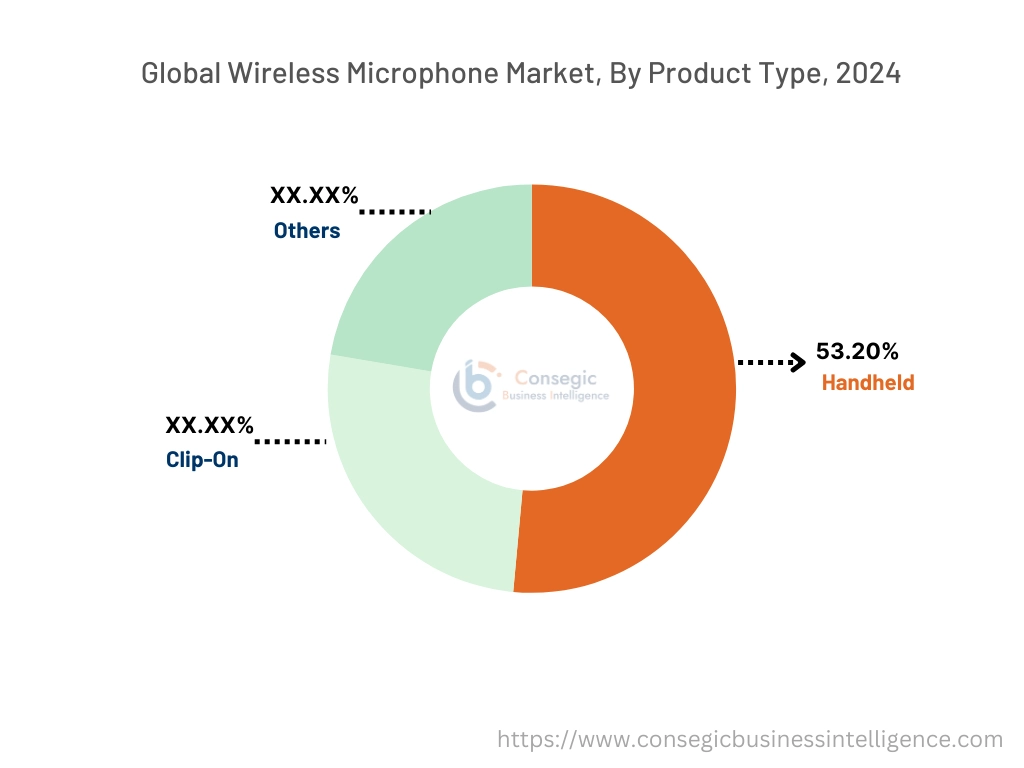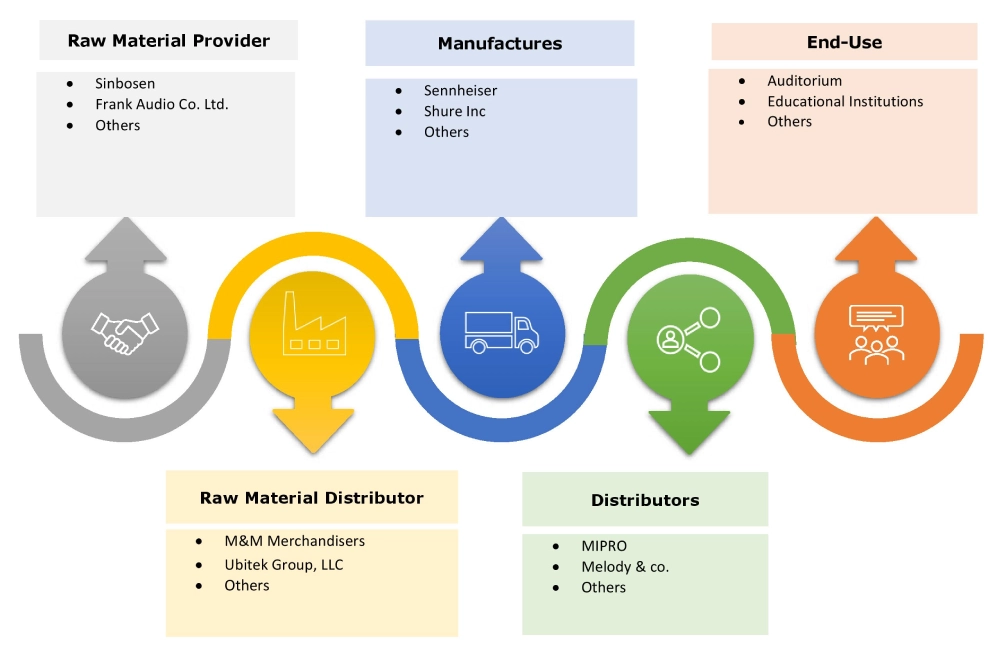- Summary
- Table Of Content
- Methodology
Wireless Microphone Market Size:
The wireless microphone market size is estimated to reach over USD 4,201.20 Million by 2032 from a value of USD 2,453.27 Million in 2024 and is projected to grow by USD 2,581.23 Million in 2025, growing at a CAGR of 7.6% from 2025 to 2032.
Wireless Microphone Market Scope & Overview:
Wireless microphones are microphones that transmit audio without any physical connection, using a transmitter and receiver. The transmitter, mostly battery-operated, picks the audio signals from the microphone converts them into digital or analog signals, and transmits them. The receiver then picks up the digital or analog signals and converts them back into the audio signals. These microphones operate over a long distance and offer higher mobility, durability, and flexibility than wired microphones. They are available in various types, such as handheld, clip-on, headset, and others. They are used for live performances, live streaming, teaching, speeches, karaoke, sports events, and conferences among others.
Key Drivers:
Rising Live Performances and Concert Culture Across the Globe Drives the Market
The rising popularity of live performances, live entertainment events, and concerts is fueling the demand for these microphones. These microphones allow artists to freely interact with the audience, without being restricted by the cables. They also offer flexibility to artists to engage in energetic and hassle-free performances. The high-quality microphones with active noise cancellation technologies provide better audio quality even in loud crowd spaces. Moreover, advanced microphones also use higher frequency bands such as UHF and VHF to ensure seamless communication.
- For instance, a report published by Pollstar states that, in 2024, the top 100 highest-grossing music tours worldwide generated a revenue of USD 9.5 billion. This marks the growth of the live entertainment industry.
Thus, the aforementioned factors are driving the utilization of wireless microphones in concerts and live performances, thereby boosting the wireless microphone market growth.
Key Restraints:
Intervention Issues Related to Wireless Microphones Limits the Market
Intervention is the most common issue related to wireless microphones. Intervention occurs when other devices use the same frequency as the microphone. As the number of wireless devices increases, this causes frequent signal clashes and intervention issues. If the frequency overlaps, the audio quality decreases due to noise, distortion, or dropouts. This makes it difficult for professionals to rely on these microphones in crucial live settings.
Thus, the issues related to intervention hamper the microphones’ audio quality, in turn hindering the wireless microphone market demand.
Future Opportunities :
Integration of Artificial Intelligence (AI) and Machine Learning (ML) Opens New Wireless Microphone Market Opportunities
The integration of AI in microphones improves the audio quality, as the algorithms continuously analyze the incoming audio signals, focus on the speaker’s voice, and reduce other unwanted sounds. The adaptive sound profiling allows the microphone to adjust as per the user’s surroundings. This creates an immersive experience catering to user preferences and needs.
- For instance, RGBlink provides an AI mini wireless microphone that offers active noise cancellation. It also supports reverb sound effects and one-touch noise cancellation.
- Additionally, ROG’s AI-powered noise-canceling wireless microphone is able to eliminate over 50 million types of background noise with up to 95% accuracy.
Moreover, these algorithms are continuously adapting, updating, and optimizing the processes, to adjust to different types of environments, sounds, and noises. This feature is very useful for situations where immediate noise cancellation is needed.
Thus, the integration of artificial intelligence and machine learning enhances noise cancellation, reduces noise, and improves audio quality by analyzing the user environment, in turn, creating new wireless microphone market opportunities.
Wireless Microphone Market Segmental Analysis :
By Product Type:
Based on product type the market is segmented into handheld, clip-on, and others.
Trends in the Product Type:
- The compact and lightweight on-camera microphones are used by content creators, and podcasters to enhance the audio quality, without comprising the camera quality, in turn driving their usage.
- Manufacturers are placing a great emphasis on the ergonomics of the headset microphone to offer a comfortable fit for longer use, which is driving the segment.
The handheld segment accounted for the largest revenue share of 53.20% of the total wireless microphone market share in 2024.
- The handheld microphones consist of a handle, a microphone capsule, and an amplifier. In handheld microphones, the transmitter is built into the unit, and does not need a separate transmitter.
- These microphones can also be clipped onto a stand when needed, providing flexibility to the user.
- These microphones are better at picking up the user’s voice and removing unwanted noise.
- They are widely used in live performance settings, interviews, journalism, public events, karaoke, entertainment events, and outdoor events, among others.
- For instance, Sennheiser offers XS Wireless 1 Dual, a system for singers and presenters. It operates on Ultra High Frequency (UHF), with built-in antennas. With its cardioid polar pattern in function, it provides 10 hours of power backup.
- Thus, the aforementioned factors show that the wide applications of handheld microphones are boosting the market growth.
The clip-on segment is expected to be the fastest-growing segment during the forecast period.
- A clip-on microphone, also known as a lavalier or lapel microphone, has the ability to attach to the user’s clothing.
- These handsfree, small, and compact microphones capture clear audio with reduced background noise.
- Moreover, these microphones are compatible with smartphones tablets, and laptops, making them preferable for shooting or recording in outdoor events or spaces.
- For instance, in February 2025, Maono announced its Wave T5 wireless lavalier microphone, specially designed for content creators and video producers. Its advanced noise cancellation features 3 modes along with 14 levels of noise reduction. Moreover, it also provides a 30-hour battery backup.
- Due to the above-mentioned features, these microphones are projected to have the fastest CAGR during the forecasted period.

By Operating Frequency:
Based on the operating frequency, the market is divided into 1.9 GHz, 2.4 GHz, Very High Frequency (VHF), and Ultra High Frequency (UHF).
Trends in the Operating Frequency:
- Increasing utilization of 1.9 GHz microphones due to their low crowded spectrum, enhanced audio quality, and extended transmission range.
- Rising adoption of AI-powered dynamic frequency selection (DFS), attributing to its ability to automatically adjust channels to avoid intervention.
The 2.4GHz segment accounted for the largest revenue in the market in 2024.
- The 2.4 GHz operates in a spectrum between 2400 MHz to 2483 MHz at a spectrum of 83 MHz.
- This system is commonly used worldwide due to its operational simplicity and cost-effectiveness. Moreover, this band range is accepted for wireless consumer devices and can be used license-free globally.
- For instance, in January 2025, Hollyland LARK M2S launched a new 2.4 GHz wireless microphone. It comes with a dual transmitter and multiple receiver options. It has a transmission range of 300 m.
- Therefore, the aforementioned factors state that the wide applications and benefits of the 2.4 GHz band and its usage in microphones are driving the market growth.
The ultra-high frequency (UHF) segment is expected to be the fastest growing segment during the forecast period.
- The UHF is a frequency range between 300 MHz to 3 GHz, primarily operating in between 470-698 MHz.
- The UFH microphone systems are able to cater to 5-6 wireless systems at the same time and are able to provide clear high-quality audio in crowded radio environments.
- Moreover, these systems are expensive, and mostly used in concerts, sports venues, live entertainment events, and stadiums.
- For instance, in September 2024, Sennheiser launched its new EW-DP ENG Wireless System with UFH stable and reliable connection. Its new receiver design is specifically designed to be mounted on a camera.
- Thus, the aforementioned benefits offered by UHF microphones will boost the wireless microphone market trends during the forecast period.
By Communication Technology:
Based on the communication technology, the market is divided into Bluetooth, Wi-Fi, RF, and Others.
Trends in the Communication Technology:
- Wi-Fi 7 integration offers improved speed, lower latency, and better multi-device connectivity, in turn enhancing real-time audio performance, and driving the consumer interest.
- Advancements in AI-driven real time spectrum scanning ensures stable connections by dynamically switching to the best available channel, in turn, boosting the segment.
The Bluetooth segment accounted for the largest revenue in the wireless microphone market share in 2024.
- The Bluetooth microphone systems operate on Bluetooth technology to transmit the signals.
- These systems provide stable and quality connections as they reduce the back-and-forth communication between the receiver and transmitter. This improves the channel classification and identifies distinct and clearer channels for signals to travel.
- For instance, Sony’s digital Bluetooth wireless microphone provides a stable range of 650 feet with its Bluetooth connection. It also consists of Lithium-ion rechargeable battery for long shooting duration.
- Thus, the aforementioned factors are driving the wireless microphone market growth.
The RF segment is expected to be the fastest growing segment during the forecast period.
- RF refers to radio frequencies used to transmit audio signals from a transmitter to a receiver in the microphone system.
- It works by converting sound waves into an electrical signal, modulating it onto an RF carrier wave, and transmitting it to the receiver.
- This offers low latency and is battery efficient. Moreover, they also offer reduced distortion or dropouts during transmissions.
- For instance, RFVenue provides a wide range of RF products to create a functional antenna system for a wireless microphone system receiver.
- Therefore, the factors stated above show that the RF segment will boost the market in the upcoming years.
By Power Backup:
Based on the power backup, the market is trifurcated into up to 10 hours, 10 to 20 hours, and above 20 hours.
Trends in the Power Backup:
- Rising integration of solar-assisted charging in wireless microphones is driving the market.
- Increasing adoption of graphene batteries due to its faster charge cycles and increased lifespan.
The up to 10 hours segment accounted for the largest revenue in the market in 2024.
- Microphones with power backup up to 10 hours are most widely used for live events, concerts, educational lectures, and street performances, among others.
- This ensures uninterrupted performances, extended events, and full-day workshops, among others.
- For instance, Rode offers wireless PRO microphone system in its product offerings, with a power backup of 7 hours.
- Hence, the above-mentioned factors showcase the wide usage of these microphones, thus driving the market.
The 10 to 20 hours segment is expected to be the fastest growing segment during the forecast period.
- Microphone system with power backup ranging from 10 to 20 hours provide improved operational capacity for long hour usage.
- It is mostly used in outdoor settings, harsh weather conditions, long shoot schedules, or for live coverages of sports events.
- For instance, ClearOne offers DIALOG UVHF microphone system in its product offerings, with a power backup of 12 hours.
- Thus, segmental analysis depicts that the improved power backup of these microphones is expected to boost its usage during the forecast period.
By Transmission Range:
Based on the transmission range, the market is divided into up to 50 m, 51 to 150 m, and above 150 m.
Trends in the Transmission Range:
- Automatic channel hopping and adaptive transmission offer a higher transmission range with low latency in turn boosting the market adoption.
- Advancements such as hybrid connectivity, and multi-channel operation are driving the growth.
The up to 50 m segment accounted for the largest revenue in the total market in 2024.
- Microphone systems with transmission range up to 50 m are used in closed auditoriums, small college or corporate events, classroom lectures, interviews, podcasts, or content creation.
- They offer high-quality audio with less intervention and extended battery life due to less power usage.
- For instance, Boya’s OMIC offers a transmission range of 50 meters with a battery backup of 15 hours.
- Thus, the analysis of the segment shows that the above factors are driving this segment’s growth in the market.
The 51 to 150 m segment is expected to be the fastest growing segment during the forecast period.
- Microphones with transmission range from 51 to 150 m are primarily used for large event venues including stadiums or sports events, conferences, auction shows, outdoor events, political rallies, and others.
- These systems offer flexibility and the ability to interact with the crowd freely.
- However, these systems have higher latency and are more prone to distortions during the audio transmission.
- For instance, Shure’s BLX wireless microphone systems offer a range of 100 meters with a battery backup of 15 hours.
- Thus, analysis portrays that the above-mentioned factors showcase the growing use of these systems, thereby, driving their demand during the forecast period.
By Distribution Channel:
Based on the distribution channel, the market is bifurcated into online and offline.
Trends in the Distribution Channel:
- Rising integration of data analytics in online shopping platforms to offer personalized product recommendations and enhance user engagement.
- Increasing adoption of offline shopping to enable buyers to assess sound quality, range, and intervention resistance before purchasing the microphone.
The offline segment accounted for the largest revenue share in the market in 2024.
- The offline distribution channel refers to physical retail stores and authorized resellers.
- The consumer gets a hands-on product experience, and immediate availability of the product.
- Moreover, the offline purchases also have after-sales technical support and installation.
- Consumers have the opportunity to test products, buy accessories, look for various options in one place, and even guidance and consultations from the shopkeepers.
- Thus, the analysis shows that the above benefits offered by offline sales is driving the wireless microphone market demand.
The online segment is expected to be the fastest growing segment during the forecast period.
- The online distribution channel refers to e-commerce platforms, official websites, or marketplaces.
- These platforms offer convivence, wider options, product variety, lower prices, and higher offers and discounts as there is no middleman, easy returns, and various payment options.
- Moreover, consumers are also able to check reviews and ratings from previous buyers to ensure quality checks and experience.
- Thus, the segmental analysis depicts that with the wide benefits offered by online distributors, the market is expected to grow in the upcoming years.
By Application:
Based on the application, the market is segmented into auditoriums, educational institutions, offices & conference rooms, sports venues & stadiums, shopping malls, airports, and others.
Trends in the Application:
- Wireless microphones integrated with public address systems, smart IoT-based communication networks, and the cloud allow remote control of these systems, which is boosting their applications.
- Wireless microphone systems support multi-zone transmission, allowing targeted announcements to specific areas.
The auditorium segment accounted for the largest revenue share in the market in 2024.
- Auditoriums are large, closed spaces where several large gatherings or functions are conducted.
- Corporates host conferences, seminars, and meetings, educational institutions host award ceremonies, presentations, guest lectures, and others.
- These functions require better and clearer audio quality, with minimal intervention and distortions.
- Therefore, the wireless microphone market analysis shows that as there is a rising need for audio systems in the auditorium, there is a growing demand for advanced wireless microphone systems.
The sports venues & stadiums segment is expected to be the fastest growing segment during the forecast period.
- The increasing number of sporting events and entertainment shows worldwide require advanced microphone systems for broadcasting and performing.
- The sports broadcast requires high-quality audio systems for on-field commentary, reporting, and interviews as the background is noisy and crowded.
- Moreover, entertainment events also need high-quality audio systems with less intervention for enhancing the communication between the artists and the crowd.
- Thus, the benefits provided by wireless microphones and their rising usage in sports venues & stadiums are expected to drive the wireless microphone market trends during the forecast period.
Regional Analysis:
The regions covered are North America, Europe, Asia Pacific, the Middle East and Africa, and Latin America.

Asia Pacific region was valued at USD 617.84 Million in 2024. Moreover, it is projected to grow by USD 651.93 Million in 2025 and reach over USD 1,094.41 Million by 2032. Out of this, China accounted for the maximum revenue share of 32.7%. The wireless microphone market analysis shows that this progress is prominently due to the rising number of content creators, podcasters, live streamers, and vloggers. These professions need better-quality microphones that are also cost-effective. Moreover, the fast-growing sports industry in the region is also a contributing factor for the market growth.

North America is estimated to reach over USD 1,491.42 Million by 2032 from a value of USD 883.07 Million in 2024 and is projected to grow by USD 928.07 Million in 2025. The wireless microphone market expansion in the region is primarily due to the well-established and growing concert culture in the region. Moreover, the rising number of live entertainment events, sports events, and karaoke are among other factors driving the market expansion.
Additionally in Europe, the growing demand for media, entertainment, and performance arts is increasing the adoption of these microphones, in turn propelling the market.
- For instance, in February 2025, Sennheiser showcased its products in 18 partner booths at Integrated Systems Europe (ISE) 2025.
In the Middle East & Africa, the market is driven by rising demand in tourism, entertainment hubs, and venues. Many countries in the region are investing heavily in tourism infrastructure, and hosting international events, conferences, and exhibitions. This increases the requirement for reliable, high-quality audio systems and solutions.
- For instance, in October 2023, Sony (MEA) expanded its microphone series with ECM-W3, ECM-W3S, and ECM-S1. These microphones are ideal for live streams, interviews, shoots, and podcasts.
In the Latin America region, as disposable income rises, both consumers and businesses are willing to invest in premium audio equipment, which is driving the wireless microphone market expansion.
Top Key Players and Market Share Insights:
The wireless microphone industry is highly competitive with major players providing products to the national and international markets. Key players are adopting several strategies in research and development (R&D), product innovation, and end-user launches to hold a strong position in the global wireless microphone market. Key players in the wireless microphone industry include -
Recent Industry Developments :
Partnerships & Collaborations:
- In February 2025, DPA launched its N-series wireless microphone system. Along with its transmitter, receiver, and handheld mic, this system also comprises an audio controller and a software solution.
- In November 2024, DJI announced the launch of its wireless microphone ‘Mic Mini’. It has both magnetic and clip-on attachment options. Moreover, it features a level noise-cancelling system.
- In October 2024, Sennheiser introduced the Profile Wireless, a microphone system operating on 2.4 GHz. This system connects to mobile phones, computers, or tablets. Moreover, it can be used as a handheld, clip-on or table-top microphone.
Wireless Microphone Market Report Insights :
| Report Attributes | Report Details |
| Study Timeline | 2018-2032 |
| Market Size in 2032 | USD 4,201.20 Million |
| CAGR (2025-2032) | 7.6% |
| By Product Type |
|
| By Operating Frequency |
|
| By Communication Technology |
|
| By Power Backup |
|
| By Transmission Range |
|
| By Distribution Channel |
|
| By Application |
|
| By Region |
|
| Key Players |
|
| North America | U.S. Canada Mexico |
| Europe | U.K. Germany France Spain Italy Russia Benelux Rest of Europe |
| APAC | China South Korea Japan India Australia ASEAN Rest of Asia-Pacific |
| Middle East and Africa | GCC Turkey South Africa Rest of MEA |
| LATAM | Brazil Argentina Chile Rest of LATAM |
| Report Coverage |
|
Key Questions Answered in the Report
How big is the wireless microphone market? +
The wireless microphone market size is estimated to reach over USD 4,201.20 Million by 2032 from a value of USD 2,453.27 Million in 2024 and is projected to grow by USD 2,581.23 Million in 2025, growing at a CAGR of 7.6% from 2025 to 2032.
What are the major segments covered in the wireless microphone market report? +
The segments covered in the report are product type, operating frequency, communication technology, power backup, transmission range, distribution channel, and application.
Which region holds the largest revenue share in 2024 in the wireless microphone market? +
North America holds the largest revenue share in the wireless microphone market in 2024.
Who are the major key players in the wireless microphone market? +
The major key players are Sony (Japan), Boya (China), Saramonic (China), DJI (China), Shure Inc. (U.S.), Rode (Australia), JBL - Harman International Industries, Incorporated. (U.S.), Bestor (India), DPA Microphones (Denmark), and Sennheiser (Germany).



